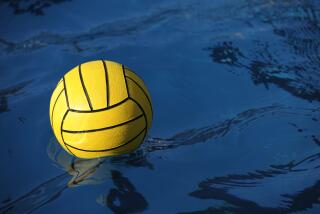WESTSIDE COVER STORY : Hard Times ON THE Polo Circuit
- Share via
Domingo Questel crouches forward in the saddle, his horse’s hoofs digging up divots in the plush, closely cropped grass. His left arm extended, he swings his mallet and, with one long, pendular swipe, sends a small white ball sailing to the far end of the field--with a pack of uniformed equestrians in hot pursuit.
The occasion is a tournament in Pacific Palisades, at the emerald-green polo field in Will Rogers State Park. Questel is riding this day with a team of corporate executives, doctors and lawyers, but he’s not one of them.
He’s a hired gun.
Like half a dozen other professional polo players who are regulars at Will Rogers, Questel makes his living tournament-to-tournament--paid by well-heeled amateur teammates, called patrons, to bolster their competitive play.
The life of such pros, who number about 500 nationwide, belies polo’s image as the sport of royalty, the rich and the famous. Most play without guaranteed contracts. They receive no medical insurance in a sport in which serious injuries abound. And their expenses, which include keeping a string of several ponies, are steep.
In fact, most polo pros make barely enough to get by. Only about 100 of the professionals who belong to the United States Polo Assn. earn enough to do nothing but play the game.
“It’s the lot of the average polo pro, the ones who aren’t getting the top jobs and are below the elite level, to just make a living,” says Edward Scanlon, treasurer of the polo association, the governing body of the sport.
It’s a message Questel constantly hammers home to Manuel, his 10-year-old son. “I tell him every night to go to school and study hard to be someone, not to play polo,” says the Moorpark resident, who also has two daughters. “It’s too hard to make a living.”
The polo circuit isn’t the first place one would expect complaints about hard economic times. Described as the sport of kings, polo is decidedly upscale, as the membership of the Will Rogers Polo Club attests.
The club counts among its members real estate developers and financiers, a television producer, a surgeon, a manager of rock ‘n’ roll bands, several corporate CEOs and a string of attorneys. Sonny Sassoon, Vidal’s son, belongs.
It’s definitely the Mercedes and BMW crowd, though Will Rogers Polo Club is less exclusive than most. At one of the club’s recent tournaments, picnickers lined the field, many of them eating pink-boxed lunches and sipping wine. A number of women in the crowd wore sun dresses and straw hats, and men sported golf shirts and khakis.
“There is affluence here, but in a non-pretentious sort of way,” says Westside resident John Greer, who was at Will Rogers with his wife, Carrie, to watch the match. “I would like to get involved in the sport if I had the wealth to do it.”
Yet for most pros--generally one or two of whom play on each four-member team--polo is no windfall. Although pros with the best handicaps (see sidebar, Page 15) command large fees, the majority do not. Questel, clearly better than his amateur teammates but in the middle rank among pros, earns from $700 to $1,000 for a two-day weekend tournament at Will Rogers. That, players say, is the average range of pay for someone at his skill level.
The earnings vary depending on how often tournaments are held. Another factor is location. In Southern California, tournaments in Santa Barbara and Indio attract wealthier patrons, who pay more to have a pro on their teams.
And the lifestyle is not that of a high-flying professional athlete. Like many other pros, Questel, 39, hauls his own horse trailer with a pickup, traveling to polo tournaments across Southern California in trips that each last up to four or five days. From January until the end of April, he plays often in Indio, where there are roughly 17 fields and some of the biggest money that California polo has to offer. From May to July, he plays frequently in Santa Barbara. Then he competes at Will Rogers through October, when the season ends.
On the road, there is no four-star hotel room to repair to at the end of the day; often it’s a bargain motel.
*
The costs can be daunting. The meter starts ticking with the price of a polo pony--up to $12,000 or more. Players need at least two, and most have four or more so they can hop on a fresh mount between periods, called chukkers, in a match.
Keeping a horse--which means paying for stable space, grooming, feeding, shoeing and veterinary service--costs an average of $4,800 a year, pros say. Tack--equestrian equipment such as saddles and bridles--is another $1,000. The wooden mallets, which break frequently, run about $95 each.
Then there are the polo club memberships that pros must pay if their patrons do not pay for them. The Will Rogers Polo Club charges about $3,000 a year, or $250 a month--inexpensive compared to some clubs, where membership can cost $18,000 or more a year.
For Questel and other polo pros, these expenses can become burdensome because there is no guarantee there will be enough tournament income to cover the bills.
If there is no patron, there may be no paycheck.
“Sometimes they call you, but sometimes you have to sit down and call them to find out if they want you,” he said.
Many polo pros try to develop other income sources. Questel, for instance, buys, trains and sells horses when he’s not involved in tournaments. Mark Cruse, a 40-year-old pro from Thousand Oaks who belongs to the Will Rogers club, not only trades polo ponies, he also manages ranches and consults with people who want to build them. And he referees polo matches, which pay about $500 apiece.
Such sidelines become crucial in the event of injuries, a persistent hazard on the polo circuit. Separated shoulders, broken bones and sprains are common. Players, who race up and down the field on horses galloping at about 35 m.p.h., say they never walk off the field without a fresh bruise or cut.
At a recent match at Will Rogers, one player’s departure with a broken collarbone barely slowed play. Questel lost an eye to the sport in his first year of play, 1979, when a mallet struck him in the face. He now wears an eye patch.
“If you haven’t been injured, you’re not playing the game right,” says C.D. LeBlanc, a 95-year-old former polo amateur who remembers the days when Will Rogers himself played Sunday afternoons on the field that bears his name. LeBlanc had his nose broken at least half a dozen times and says he crushed or shattered numerous other bones.
Through it all, the pros keep playing. For Questel, the reason is that since his childhood in the Dominican Republic, polo has been what he does best. For Bruce Gaither, a 34-year-old Will Rogers club member from Sun Valley, it’s that he simply loves the sport.
Gaither chose polo over law school.
“I didn’t want to go through life just trying to earn money,” he says. “Sometimes I can’t believe God lets me do this for a living.”
Gaither is typical of most professional polo players--a skilled rider who started out as a stable hand and eventually moved on to the polo field. In 1983, he dropped out of college in Florida. With $11 and a dog, he moved into a tent, his job as a stable hand leaving him just enough money every week to buy apples, peanut butter and dog food.
Eventually, he got his chance. He trained horses for a patron who, during polo matches, faked that he had groin injuries so he could put Gaither in as his replacement.
Today, in addition to playing, he teaches polo in clubs throughout Southern California.
“I tried to make it as just a polo pro and I starved,” he says.
*
Patrons and pros both acknowledge that many pros have a hard time on the polo circuit, but there is no serious effort on either side to change the situation. The pros do not appear eager to organize and the patrons seem unlikely to improve their pay.
Polo pros recognize that although they raise the level of competitiveness on the field, their services are easily replaced, even eliminated.
Patrons agree.
“Polo is played by a lot of Republicans who are not friends of the unions by any stretch of the imagination,” says Scanlon, who has sponsored professional players himself. “If Domingo all of a sudden costs you $18,000 (a year) instead of the $9,000 you’re used to, you’ll call a couple of friends and play with them instead.”
Increasing polo’s visibility is the best way to make the game a lucrative sport for more of its professional players, Scanlon says. The key, he says, is attracting television coverage; the U.S. Polo Assn. is working on a plan to have the sport televised as early as next year.
In addition, the International Polo Federation is negotiating with the International Olympic Committee to once again make polo an Olympic event. Polo players have not taken part in the Olympics since 1936. The International Olympic Committee is reluctant to put polo back, Scanlon says, because it considers equestrian events too costly.
None of that matters to Gaither, who says he will continue to play polo professionally even if the money and exposure never improve.
“I’m pretty addicted to this polo thing,” he says. “I just wish that I had started playing a lot earlier.”
Questel takes a dimmer view of life as a polo pro. “I don’t recommend it,” he says.
More to Read
Go beyond the scoreboard
Get the latest on L.A.'s teams in the daily Sports Report newsletter.
You may occasionally receive promotional content from the Los Angeles Times.










